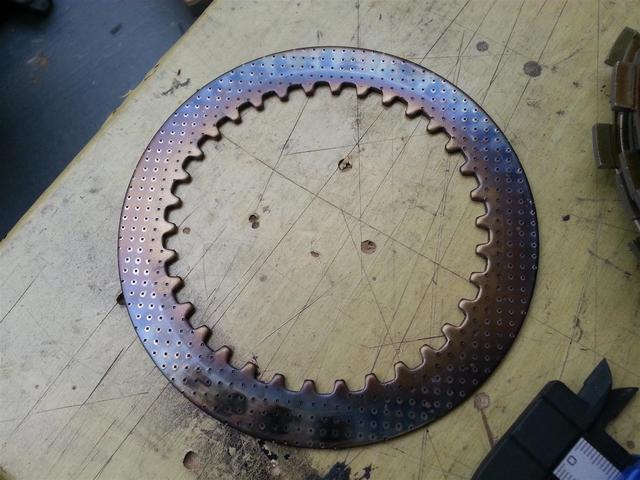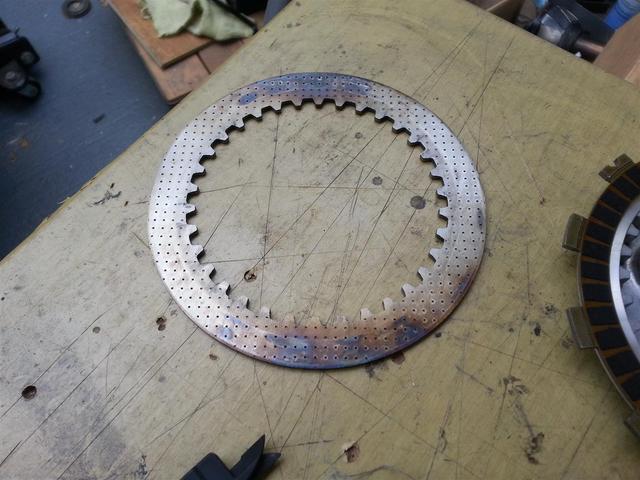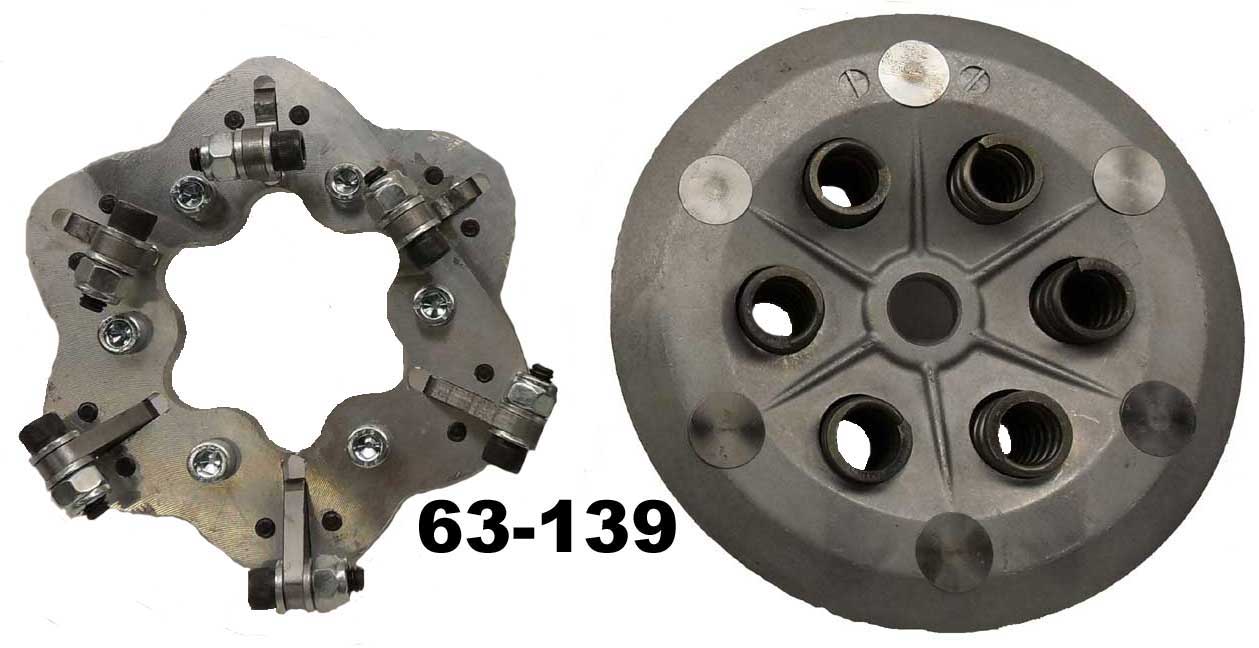theprisioner
|
| posted on 20/5/14 at 07:55 AM |

|
|
Hayabusa BEC clutch advice
I am replacing my Hayabusa clutch in my Westfield and need some advice. The advice I have had so far is confusing and contradictory.
I have been told that the failure is usually in the steels and that is borne out by my experience, one of the steels in my build is in fact cup shaped
and blue in colour from over heating. The friction plates are mostly ok in appearance except the one next to the burnt steel which is slightly
carbonised. The build that failed had the uprated springs.
I have been told that the best clutch for sprinting/hill climbs is a Barnett clutch with uprated springs. Apparently the steels in a Barnett clutch
are made slightly differently and last longer. The only claim I can find for a Barnett clutch is it lasts 50% longer, has Kevlar in the friction
plates and has stronger springs as an option. You have to replace the whole build up as the dimensions are different for the individual plates.
Some advice I have been offered recommends the Barnett stronger springs and standard Suzuki friction/steels as the steels are the point of failure and
it matters little whose steels you use.
Any clarification you can offer would be much appreciated as usual.
http://sylvabuild.blogspot.com/
http://austin7special.blogspot.co.uk/
|
|
|
|
|
wombat258
|
| posted on 20/5/14 at 08:42 AM |

|
|
My experience is that Barnett springs are good, but their plates are inferior to the OEM Suzuki plates. I have had slip and shudder problems with
Barnett, and no problems at all with genuine Suzuki clutch plates.
|
|
|
jwhatley
|
| posted on 20/5/14 at 02:03 PM |

|
|
I use standard Suzuki steels and plates with uprated springs and lock up plate. I have never had an issue with mine using that setup.
If you are getting judder you need to get a back torque eliminator fitted to stop that.
|
|
|
40inches
|
| posted on 20/5/14 at 02:22 PM |

|
|
I take it that the failure is slipping?
Not a Busa, but my steels look like this:
 
Description
 
Description
I have a full set of gen steels and friction plates to put in, but as yet, the clutch isn't slipping
|
|
|
theprisioner
|
| posted on 20/5/14 at 04:08 PM |

|
|
Yup, one of my steels not only looks like that but is slightly cupped! Please explain lockup plate?
http://sylvabuild.blogspot.com/
http://austin7special.blogspot.co.uk/
|
|
|
40inches
|
| posted on 20/5/14 at 04:32 PM |

|
|
quote:
Originally posted by jwhatley
I use standard Suzuki steels and plates with uprated springs and lock up plate. I have never had an issue with mine using that setup.
If you are getting judder you need to get a back torque eliminator fitted to stop that.
Blimey! A lot of tech speak there!  Could you explain what a lock up plate and back torque eliminator is? Please Could you explain what a lock up plate and back torque eliminator is? Please Or a link to Or a link to
a website?
|
|
|
jwhatley
|
| posted on 20/5/14 at 04:32 PM |

|
|
The lock up clutch effectivly puts extra pressure on the clutch pressure plate when the wheels are spinning to stop clutch slip at speed.
A lock up clutch has flyweights attached to an arm on the end of the clutch which is bolted to the pressure plate of the clutch basket. you can
increase the weight of the flyweights to put the pressure on earlier, or remove weight to put the pressure on later.
There more suited to high power/torque applications and drag bikes. But do work well in BEC cars too.
They allow you to run softer springs to get a good launch then eliminate clutch slip when you are going by throwing the flyweights out and putting
more pressure on the pressure plate.
Looks like this:

[Edited on 20/5/14 by jwhatley]
|
|
|
jwhatley
|
| posted on 20/5/14 at 04:48 PM |

|
|
Back torque limiter is a small key wayed part fitted in to the clutch basket of the hayabusa engine.
What its used for is to allow the clutch to slip on downshifts on the bike, stopping the wheels locking up through engine breaking. In BEC its not
quite as serious because we have a differential, two wheels and a foot operated clutch or auto blipper that may be used on downshifting to stop this
happening. As you can imagine it is quite a bit more serious on a bike!
It also is a torque limiter, which will jump out and slip the clutch if you put too much torque through the engine trying to pull away like a mad
man.
Some people may have experienced clutch judder when pulling away or tramping, this can be caused by the torque limiter. This is not what you want
especially in a drag racing situation.
The eliminator stops the torque limiter jumping out of its position, its effectively a plate you bolt in to the clutch basket to stop it coming
out.
A few pictures for you:
Back torque limiter in the clutch basket:

This is what happens when is disengages, and allows the basket to spin:

And this is an eliminator fitted:

These three blogs really helped me understand the whole setup of the clutch if you are looking for performance out of it, talks about all the bits you
could ever want, plates, springs, eliminators and lock ups!!:
Part 1: http://www.dragbike.com/dbnews/templates/fast1320_z11.aspx?articleid=6747&zoneid=12
Part 2: http://www.dragbike.com/dbnews/templates/fast1320_z11.aspx?articleid=6778&zoneid=12
Part 3: http://www.dragbike.com/dbnews/templates/fast1320_z11.aspx?articleid=6835&zoneid=12
|
|
|
Custardpants
|
| posted on 20/5/14 at 05:06 PM |

|
|
If one of your steels is warped I would check the splines of the basket for smoothness as the steel plates can wear into it, preventing the clutch
plates from sliding smoothly with clutch action. I needed to replace my basket to allow the clutch plates to move smoothly. I have been told it is
best to stick with Suzuki plates as they progressively wear out rather than break up like some aftermarket ones. When I had clutch slip, I fixed it by
upgrading my springs and changing my make of oil - although I was using oil certified suitable for wet clutches it had a high moly content.
|
|
|
theprisioner
|
| posted on 20/5/14 at 10:09 PM |

|
|
This thread is fabulous thanks for all your advice. I decided to fit a Barnet clutch. I note the steels are 0.25mm thicker and the friction plates
thinner to compensate. The steels have no pot holes like indents in them. I will see how it goes and report back. Apparently all the BEC's at
Knockhill use these clutches and so do some of the local BEC hill climbers. I tried it in the garage and everything is working again I will take it to
Forestburn test night tomorrow.
http://sylvabuild.blogspot.com/
http://austin7special.blogspot.co.uk/
|
|
|













